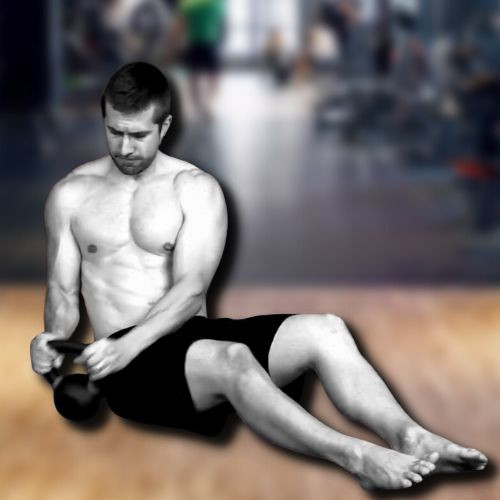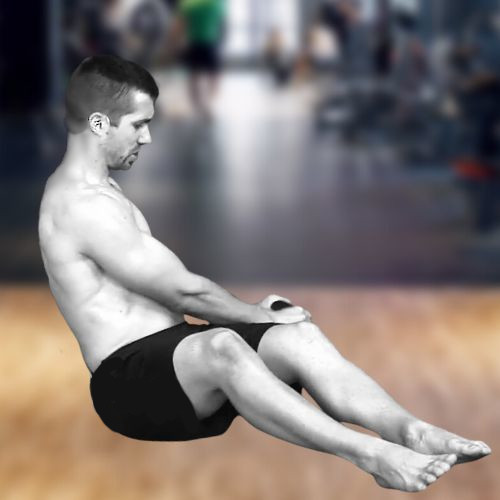On the hunt for those chiselled abs and sharply defined obliques? Trust me, I understand the challenge of navigating through a sea of exercises, each promising to be your golden ticket. Well look no further, the Kettlebell Russian Twist is the exercise for you.
For years I was going through the motions with workouts until I found Kettlebell workouts and then when I needed a good kettlebell ab workout I stumbled upon the Kettlebell Russian Twist. Do note this workout will target your abs and obliques like you’ve never experienced before!
What is Kettlebell Russian Twist?
Kettlebell Russian Twist is an effective exercise that targets the obliques and core muscles. It involves twisting your torso while holding a kettlebell, working on rotational strength and stability.
How to perform the Kettlebell Russian Twist
I want to share how to do Kettlebell Russian Twists the right way. This exercise is great for your abs and obliques.
- Lift your feet off the ground slightly. If you’re new, keep them down until you’re stronger.
- Twist your torso to one side bringing the kettlebell towards the floor.
- Keep your eyes on the weight; this helps with balance.
- Now twist to the other side doing the same motion.
- Breathe out as you twist and breathe in when returning to center.
- Do these twists back and forth at a good pace but don’t rush.
- Count each side as one rep and aim for 10 – 20 reps.


Muscles worked: Obliques and Core
The Russian Twist is great for your core and oblique muscles. These are the muscles on the sides of your belly and around it. They help you turn, bend, and keep your back safe. When I do this exercise with a kettlebell, it makes those muscles work even harder.
Variations of Kettlebell Russian Twist with different levels of difficulty
The Kettlebell Russian Twist is a great ab workout. It helps build strong abs and toned obliques. Here are different ways to do it:
Basic Kettlebell Russian Twist
- Sit on the ground, knees bent, heels touching the floor.
- Hold the kettlebell close to your chest with both hands.
- Lean back a little and twist your torso, moving the weight side to side.
Elevated Feet Russian Twist:
- Lift your feet off the floor while doing the twist.
- This version works your core more because it’s harder to keep balance.
Single-Arm Russian Twist:
- Use one hand to hold the kettlebell.
- Pass it around your body, from one hand to the other as you twist.
- This move adds a challenge for your shoulders too.
Advanced Weighted Russian Twist:
- Increase the weight of the kettlebell as you get stronger.
- Make sure you can still do the exercise with good form.
Russian Twist with Leg Extension:
- While twisting, extend one leg out straight and alternate legs each time.
- This variation will work your abs even more.
Standing Russian Twist:
- Stand up and hold the kettlebell at chest level.
- Turn your upper body side to side, keeping hips forward.
- This way you work on stability and strength standing up.
Benefits of Kettlebell Russian Twist
Kettlebell Russian Twist strengthens stabilizing muscles, improves flexibility, and can aid in fat loss. It also offers athletic benefits such as enhanced rotational power and core strength.
Reinforces stabilizing muscles
The Kettlebell Russian Twist is a great way to reinforce stabilizing muscles. This exercise specifically targets the obliques, but it also engages other core muscles and stabilizers to keep you balanced throughout the movement.
Improves flexibility
Kettlebell Russian Twist is great for improving flexibility. The twisting motion engages the muscles in your core, hips, and lower back, which can enhance your overall flexibility.
Can help with fat loss
Kettlebell Russian twists can assist in fat loss by engaging multiple muscle groups during the exercise. This compound movement boosts calorie expenditure and promotes a leaner physique.
Athletic benefits
Improving athletic performance is a significant benefit of Kettlebell Russian Twist. The exercise enhances core strength, rotational power, and stability, which are crucial for sports such as golf, tennis, and baseball.
Mistakes to Avoid Kettlebell Russian Twist
One of the common mistakes to avoid when performing Kettlebell Russian Twists is using too much weight, which can lead to improper form and potential injury. Another mistake is arching your back during the exercise, which can strain your lower back and decrease the effectiveness of the workout.
Using too much weight
Using too much weight during Kettlebell Russian Twist can strain your back and increase the risk of injury. It’s crucial to select a kettlebell weight that allows you to maintain proper form throughout the exercise, without compromising your technique.
Improper breathing
Using appropriate breathing is crucial during the Kettlebell Russian Twist. When performing this exercise, I make sure to exhale as I rotate my torso and inhale as I return to the starting position.
Arching your back
When doing the Kettlebell Russian Twist exercise, it’s crucial to avoid arching your back. Arching the back excessively can strain the spine and lead to lower back discomfort or injury.
Moving your legs
When performing the Kettlebell Russian Twist, it’s crucial to keep your legs off the ground. Lift your feet and balance on your buttocks as you rotate from side to side with the kettlebell.
Who Should Avoid Kettlebell Russian Twist?
Individuals with lower back pain or existing oblique injuries should exercise caution when performing the Kettlebell Russian Twist. It’s essential to consult a healthcare professional before attempting this exercise to prevent exacerbating any existing conditions.
Read on to understand the safety precautions and alternatives for those who may need to avoid this workout.
Alternatives to Kettlebell Russian Twist
If you cannot perform the Kettlebell Russian Twist due to certain injuries or health conditions, here are alternative exercises that can target your obliques and core effectively.
- Side Plank: Hold yourself in a straight line from head to heels on one side with your elbow directly beneath your shoulder. Switch sides and repeat.
- Bicycle Crunches: Lying on your back, bring opposite elbow to knee in a twisting motion, alternating sides.
- Wood Choppers: Use a resistance band or cable machine to mimic the twisting motion of the Russian twist, engaging your core and obliques.
- Pallof Press: Standing perpendicular to the anchor point of a resistance band, extend your arms in front of you and twist away from the anchor point while resisting rotation.
- Dead Bug Exercise: Lie on your back with arms extended toward the ceiling and knees bent at 90 degrees; lower opposite arm and leg towards the ground while keeping them hovering just above the floor.
- Plank with Hip Dips: While holding a plank position, rotate at the hips to touch them down to one side of the body, then alternate to the other side.
- Medicine Ball Slams: Holding a medicine ball overhead, slam it down to each side of your body by twisting at the torso as you make contact with the ground.
- Resistance Band Twists: Anchor a resistance band at about chest height then pull and twist it across your body as you rotate through your core.
Debunking myths about its impact on waist size and defining abs
I’ve noticed there’s a popular misconception about the Kettlebell Russian Twist. Some believe it directly leads to slimming down your waist or carving out defined abs. Let’s set the record straight: no, this exercise alone won’t magically shrink your waistline or chisel out six-pack abs.
Targeted fat loss is not really a thing, and strengthening exercises like the Kettlebell Russian Twist contribute to overall muscle development rather than spot reduction. While it engages and strengthens the obliques and core, revealing those well-defined abs involves a combination of proper nutrition, overall body fat reduction, and consistent training that targets all abdominal muscles.
Comparison to other core exercises for desired results
While debunking myths about waist size and ab definition, it’s clear that the Kettlebell Russian Twist isn’t the only exercise in town for sculpting a strong core. Let’s pit it against some other popular core routines to see how they stack up in effectiveness.
| Exercise | Primary Muscles Worked | Benefits | Drawbacks |
|---|---|---|---|
| Kettlebell Russian Twist | Obliques, Core | Works stabilizers, Improves flexibility, Aids in fat loss, Athletic function | Risk of back strain, Not suitable for some injuries |
| Plank | Core, Shoulders, Glutes | Builds endurance, Strengthens multiple muscle groups | Can be static, May not be as dynamic |
| Crunches | Rectus Abdominis | Targets ‘six-pack’ abs, Easy to perform | Limited oblique engagement, Potential neck strain |
| Hanging Leg Raises | Lower Abs, Hip Flexors | Strengthens lower core, Enhances grip strength | Requires pull-up bar, Difficult for beginners |
| Medicine Ball Slams | Core, Shoulders, Lats, Triceps | Cardiovascular component, Full-body workout | Requires ample space, Medicine ball needed |
| Bicycle Crunches | Obliques, Rectus Abdominis | Engages entire core, Coordination | Hip flexor dependence, Technique-sensitive |
Keeping this comparison in mind, the Kettlebell Russian Twist offers a unique blend of benefits, but it’s crucial to consider personal goals, potential limitations, and the value of exercise variety for optimal core development.
Is the Kettlebell Russian Twist a good Exercise?
I would say that the Kettlebell Russian Twist is an effective exercise for building strong abs and toned obliques. If you’re trying to target these muscle groups then this is a perfect exercise for you!
When done correctly, the Kettlebell Russian Twist will improve your flexibility, aid in fat loss, and provide functional strength.









Leave a Reply